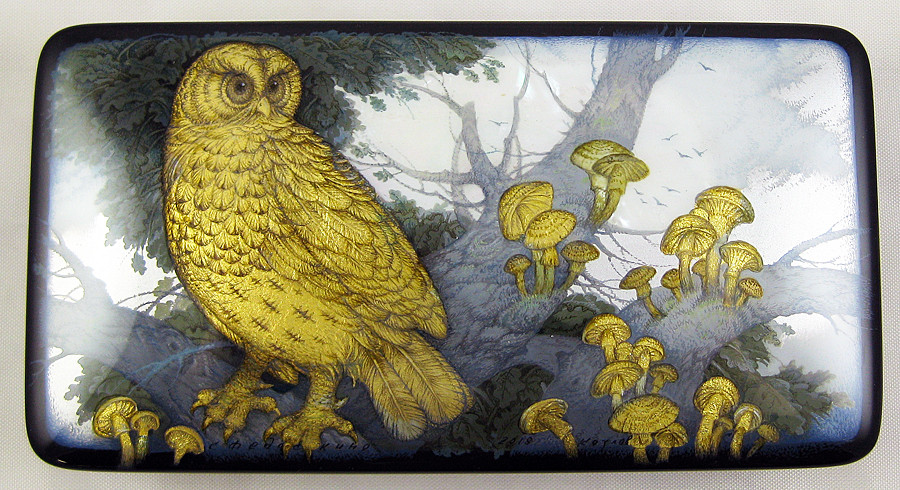Russian lacquer boxes were first produced in the late 18th century and have since become popular with art collector's throughout the world. However, this now flourishing art may not have existed if not for the introduction of affordable tobacco to Europe in the mid 18th century. Prior to this, tobacco had been so expensive that only the wealthy could afford it and cigarette cases and snuff boxes were made of gold and precious materials like ivory and tortoiseshell. When the price of tobacco came down, it immediately became popular with the common man and a market developed for inexpensive boxes to hold tobacco products. Soon several workshops in the area of Fedoskino village were producing lacquered papier-mache boxes to fill the demand. The earliest Russian lacquer workshops, such as those of Korobov, Lukutin and Vishnyakov, produced a variety of utilitarian items including snuffboxes, panels, powder cases, tea-caddies and desk accessories.
To be considered authentic, a Russian lacquer box must have been produced using traditional techniques and materials by an artist trained in one of the four official schools: Fedoskino, Palekh, Mstera, and Kholui. One must apply and be accepted to study at these schools, and basic training requires four years, after which apprenticeship begins. Prior to the dissolution of the Soviet Union, all artists were employed at the official workshop of each school. Their work was judged, graded with strict quality control, and only high quality works were exported. Today, the lacquer artists may work for the official workshop or work independently. Therefore, a factory seal or certificate is no longer a determining factor to authenticity as many fine artists now work from their homes.
These small works of art are entirely handcrafted and hand painted making each a unique, inspired creation. Techniques for producing the authentic Russian lacquer boxes have remained essentially the same for 150 years. Boxes and other objects are made of cardboard sheets, pressed and formed, then boiled in linseed oil. This papier-mache is then baked in an oven. At this point the material can be worked like wood. Trained joiners assemble the boxes, applying hinges and two coats of primer-paint. The blank is then oven dried and given to the artist to begin the painting. Extremely fine brushes are used to achieve the fine lines and details in each painting. Artists prefer to make their own brushes and mix their own pigments. A quality lacquer miniature may take several months to complete.
Making a Russian Lacquer Box
Favored themes for paintings on Russian lacquer boxes are scenes from traditional Russian fairy tales, depiction of 19th century Russian peasant life, and reproductions of famous paintings hanging in Russian museums. However, all are original works of art, signed by the artist. There are four categories of painting to be considered: one-of-a-kind compositions; limited editions by a single artist; "factory" compositions which can be used by all artists; and reproductions from original works on canvas. Quality varies among all these categories.
The art of Russian lacquer miniature painting has gained worldwide appreciation and these small treasures are highly sought after by collectors. As a result, many Russian lacquer boxes are now being produced by untrained people using inferior materials. Many of these fakes have the name of one of the four villages and even the name of a well known artist added to fool the uneducated buyer. Educating yourself about the art and buying from reputable dealers will ensure that the Russian lacquer box you purchase will be of high quality.

